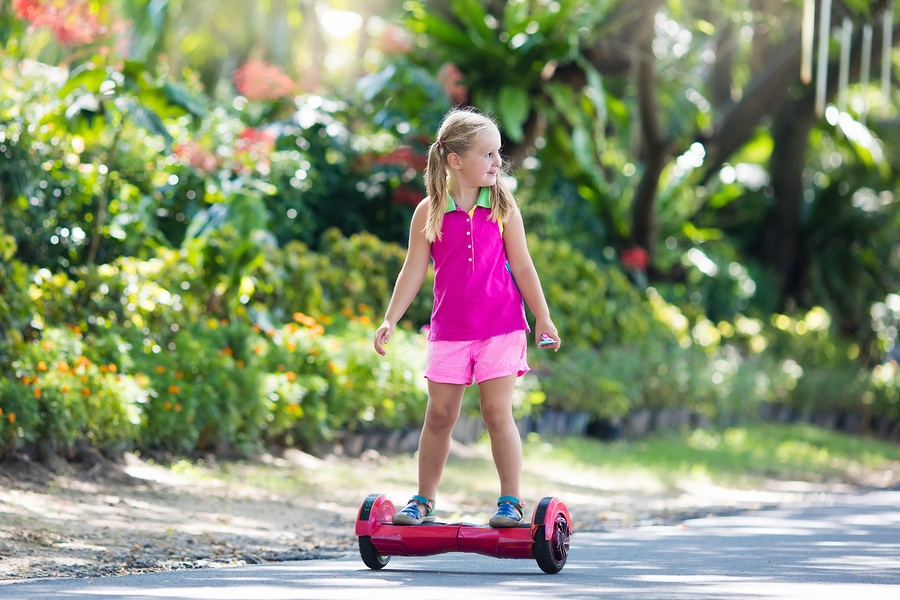Hoverboards have increased in popularity in recent years, but that doesn’t mean they have become any less dangerous. Hoverboards are electric and hands-free, self-balancing scooters. The speed of a hoverboard can range depending upon the brand, but most travel between 6 mph and 15 mph.
According to the United States Consumer Product Safety Commission, after a massive recall was issued on hoverboards in 2016, half a million of them fell under the list of defective products. Fire and explosion hazards were the leading cause of serious injuries involving hoverboards, created by companies including Sonic Smart, Smart Balance, iRover, and Vecaro.
There have also been reports of serious injuries involving fractures, broken bones and brain injuries. In warmer weather climates like Florida, many riders may be tempted to hop on a hoverboard without shoes, or while wearing flip-flops. Protective gear and supportive shoes should always be worn when riding a hoverboard.
More than 40 hoverboards caught fire and/or exploded in 19 states. The cause of the fires has been attributed to the circuit boards and lithium-ion battery explosions.
Following the 2016 hoverboard recalls, Underwriters Laboratories (UL) released a set of safety requirements that must be followed and includes several tests. Hoverboards use lithium-ion batteries, which are often prone to explosions from overheating. UL requires hoverboards to undergo battery testing that stimulates the battery cell to a significant level to see how far they can go before exploding. Their tests have also demonstrated just how serious the explosions can be in the event the battery gets punctured.
Recalls have also involved the hoverboard chargers. These are charged via USB chargers, which are not always safe. USB chargers that do not receive a UL-certificate are not required to be taken off the market. Unfortunately, there is no way to tell if a product is defective until it has been charged a couple of times. Even if the batteries on the hoverboard have been properly tested and certified, a faulty charger could still cause them to explode.
The hoverboard wires themselves have also led to some recalls. Manufacturers will try to cut corners to save money, and quality wiring is often the first thing to go. UL testing will open the hoverboards themselves and test the wiring. Many that did not pass previous tests showed wires that were exposed or bent, both of which could lead to a short-circuit and malfunction. Other times, UL testers have seen issues, such as metal shavings inside the hoverboard that could also cause these issues.
The UL 2272 stamp of certification is not always a surefire guarantee. The testing requirements for UL 2272 specifically evaluate the safety of the electrical system: the safety of the electrical drive train system and battery and charger system combinations but does NOT evaluate for performance, reliability, or rider safety. Once the hoverboard is used, it must be taken care of properly and kept in a safe working condition. It is for this reason that it is extremely important to ensure that the person riding the hoverboard knows how to use it and store it properly. Many parents see hoverboards as fun presents for their children, but if the child is not old enough to know how to use the device, the result could be deadly.
Hoverboard Top 10 Safety Tips
The following tips can be helpful when it comes to ensuring that the hoverboard is safe and used properly:
- Make sure the purchased hoverboard is UL 2272 certified;
- Be sure to not leave the hoverboard in the charger for more than three hours;
- Never leave a charging hoverboard unattended;
- Once charged, do not leave the hoverboard around for too long, meaning the fully powered hoverboard should be used for a short ride, bringing the charge to at least 90 percent;
- Store the hoverboard in a cool area when not in use, away from flammable objects;
- Research how to use a hoverboard safely before riding it;
- Do not give the hoverboard to a person who is too young or irresponsible with the hoverboard;
- Wear proper headgear and protection when using the hoverboard.
- It is advised that owners charge their hoverboards in an open area and away from combustible materials and always have a fire extinguisher readily available;
- Beware of personal liability when it comes to owning a hoverboard.
 Personal Liability for a Hoverboard Accident:
Personal Liability for a Hoverboard Accident:
Not only are there fire risks associated with hoverboards, but one must consider the risk of personal liability when it comes to owning a hoverboard. For example, if your child invites a friend from the neighborhood over and that child attempts to ride the hoverboard without proper footwear or a helmet and suffers a serious injury. If the accident occurred on your property, while under your supervision, you can be held personally liable and sued.

Legally Written and Reviewed by a Managing Partner
Wooten, Kimbrough, Damaso, and Dennis, P.A.
Our content is written and reviewed by our founding attorneys Butch Wooten, Orman Kimbrough, Mike Damaso, and Tom Dennis. Helping the injured since 1966, they’ve successfully handled thousands of personal injury cases across Florida. Whether you’re a Florida resident or an out-of-state visitor injured in Florida, we’re dedicated to providing clear and reliable information to help you navigate your legal options confidently.




